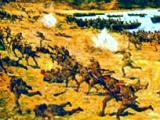Anzac
Articles
Anzac Day
First observed in 1916, Anzac Day - 25 April - commemorates those killed in war and honours returned servicemen and women. The ceremonies held at war memorials around the country, and in places overseas where New Zealanders gather, are rich in tradition and ritual. Read the full article
Page 2 - The Anzacs
The word Anzac is part of the culture of New Zealanders and Australians. The word conjures up a shared heritage of two nations, but it also has a specific meaning, dating from
Page 3 - The ceremony
The Anzac Day ceremony of 25 April is a form of military funeral and follows a specific pattern. The day's ceremonies have two major parts: one at dawn and another later in the
Page 8 - Fatalities
This list of 147 fatalities of the New Zealand Expeditionary Force was collated from Commonwealth War Graves Commission records. Most, but not all, died on 25 April
The Gallipoli campaign

Each year on Anzac Day, New Zealanders (and Australians) mark the anniversary of the Gallipoli landings of 25 April 1915. On that day, thousands of young men, far from their homes, stormed the beaches on the Gallipoli Peninsula in what is now Türkiye. Read the full article
Page 3 - Invasion
Allied forces landed on the Gallipoli Peninsula on 25 April 1915. British (and later French) forces made the main landing at Cape Helles on the southern tip of Gallipoli, while
Page 4 - Stalemate
By 29 April, the battle of the landing was over; both sides had fought themselves to a standstill. While the New Zealanders and Australians had established a beachhead at Anzac
Page 5 - The Sari Bair offensive
As the futile attacks continued at Helles, the Allies began looking at alternative strategies to break the deadlock. Lieutenant-General Birdwood, the ANZAC commander, formulated a
Page 6 - Evacuation
Hill 60 was the last major Allied attack at Gallipoli. The failure of the August offensive raised more questions about the future of the campaign, especially in light of the
Page 7 - Soldiers' experience
Life for the New Zealand soldier on Gallipoli was tough. They struggled with the harsh environment, living and fighting amongst the deep ravines and high cliffs that towered above
Page 9 - 25 April 1915: Anzac landing timeline
This timeline provides a detailed breakdown of what happened and when during the Gallipoli landings at Anzac Cove on 25 April
Passchendaele: fighting for Belgium
Ever since 1917 Passchendaele has been a byword for the horror of the First World War. The assault on this tiny Belgian village cost the lives of thousands of New Zealand soldiers. But its impact reached far beyond the battlefield, leaving deep scars on many New Zealand communities and families. Read the full article
Page 3 - The Passchendaele offensive
The failed attempt to capture the town of Passchendaele saw more New Zealanders killed in one day than in any other military campaign since
Māori in the NZEF
More than 2000 Maori served in the Māori Contingent and Pioneer Battalion during the First World War Read the full article
Page 2 - Maori Contingent at Gallipoli
The first Maori Contingent sailed from Wellington aboard the SS Warrimoo in February 1915. The contingent served on the Gallipoli

















